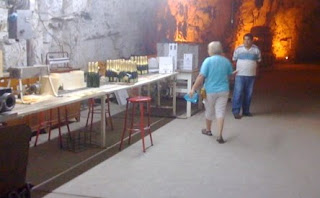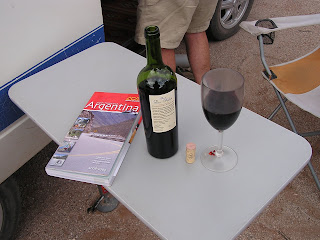Argentina Part III:
Wine Tasting:
(Various in January and February 2010)
Our first visit to viñas (bodegas) in Argentina was with the organic vineyard in San Rafael noted in my last log. However, in January and February we had the occasion to visit several wineries in the Merndoza, San Juan, and Salta Provinces. In general, the wines are quite good, and would measure up to any in California. In fact, they would do quite well against and wines in the world.
Our first major tour was in the Province of San Juan where Sharon and I hired a taxi to take us to several local bodegas. First we visited a “Champaign” bodega just west of the city of San Juan (Figures 1 & 2). This sparkling wine bodega is considered one of the best in San Juan. Maybe, but my thoughts are that it would have a hard time competing with even the most modest sparkling wine in California. Do not get me wrong, it is not bad. It is just not all that good. They also make some reds (Figure 3). However, we were not allowed to taste any. I bought a bottle of Merlot anyway. None of us liked the Merlot they produced. In fact, we threw it out after a single taste.
Figure 1. Bodega Cavas de Zonada, a sparkling wine bodega.
Figure 2. The bodega is located in an old tunnel that was created in 1928.
Figure 3. This bodega also makes some reds.
The next winery was Bodega Graffigna (Figure 4). The reds they produce are quite good (Figure 5). They claim to age their premium wines for 12 months in either French or American (Figures 6 & 7). We do buy several bottles of Merlot and Cabernet Sauvignon (Figure 8).
Figure 4. Bodega Graffigna in San Juan, Argentina.
Figure 5. Here I tried several of the red wines produced by Bodega Graffigna.
Figure 6. French oak barrel used to age wines at Bodega Graffigna.
Figure 7. American oak barrel used to age wines at Bodega Graffigna.
Figure 8. Sharon buying several bottles of red at Bodega Graffigna.
Our final bodega was a very small winery that produces only a few thousand liters of each variety a year (Figure 9) for export. However, they produce some vino patero for local consumption (Figure 10). The vino patero is not a particularly good red wine. It comes in 5 liter bottles. They allow us to taste four different red wines and two white, which I decline; Sharon does not (Figure 11). This was our first taste of a different variety, Bonarda (Figure 12). According to the young women, Bonarda is unique to Argentina. It is a very smooth, fruity wine. Later we try other Bonardas from a number of bodegas.
Figure 9. Bodega La Guarda.
Figure 10. Vino Patero produced by Bodega La Guarda.
Figure 11. Sharon tries all the wines at Bodega La Guarda.
Figure 12. I examine a bottle of Bonarda at Bodega La Guarda.
We drive north to the small town of Cafayate which is relatively well known for its red wines in the souther part of Valles Calchaquíes. Gary, Karla, Sharon, and I visit a number of wineries in the area. Our first was Bodega Etchart (Figure 13 & 14). They produce several very good wines including a sweet, desert, late harvest Torrontes (Figure 15). Torrontes, a very dry white wine, is another wine that Argentine wineries claim is unique to Argentina. Of course, since I do not like white wine, it was not my favorite. I especially enjoyed the tour because it was the first one I have been on where they were actually producing wine as we watched (Figures 16 & 17); The winery is over 170 years old (Figure 18). I try and buy several of their wines (Figure 19), including the late harvest Torrontes which is quite good.
Figure 13. Bodega Etchart outside the small town of Cafayate.
Figure 14. The Ruta del Vino in Salta Province, Sharon at Bodega Etchart.
Figure 15. Bodega Etchart produces several different wines.
Figure 16. Bringing the grapes to the bodega.
Figure 17. Starting the wine production by placing the grapes into the crusher.
Figure 18. Etchart Bodega was founded in 1850.
Figure 19. We try several of the reds and the late harvest Torrontes.
We also visit several “organic” wineries in the Valles Calchaquíes (Figures 20 to 22).
Figure 20. One of the "organic" winneries, Bodega Nanni.
Figure 21. Another organic winery, Bodega Nubes.
Figure 22. The vinyard at Bodega Nubes.
On a trip through the scenic Quebrada de Cafayate, we unexpectedly find a small bodega, Las Casa de la Bodega (Figure 23 & 24). This is a boutique hotel and small exclusive winery about 16 km northeast of Cafayate. Unfortunately, we are a bit too late to taste their wines.
Figure 23. Las Casa de la Bodega.
Figure 24. Pool at the boutique hotel.
Probably the most famous of the Cafayate wineries is Bodega El Esteco (Figure 25) producing several well known labels, including “Elementos”, “Don David”, and “Ciclos”. The tasting is expensive. We have to buy a “flight” of three to four wines. Each taste is a glass of wine for each label. So we each take a different flight and share. We try all of them (Figures 26 to 28).
Figure 25. The main building at Bodega El Esteca.
Figure 26. Sharon, Gary, and Karla in the tasting room at Bodega El Esteco.
Figure 27. John, Gary, Karla, and Sharon taste different wines at Bodega El Esteca.
Figure 28. Our hostess, Florencia, serves the wine at Bodega El Esteca.
On our way north on Ruta 40 in Salta Province, we go off the road 16 km to another boutique hotel and winery, Bodega Colome (Figure 29 & 30). We have a snack and try some of their wines which are very good and expensive (Figure 31). The cost for a night at the hotel for two is US $340. We decide to camp in the beautiful desert nearby (Figure 32 & 33). At camp we try some of our wines (Figure 34 & 35).
Figure 29. Boutique Hotel and Bodega Colome.
Figure 30. The Hotel Colome.
Figure 31. Gary, Karla, and Sharon try some snacks and wine at the restaurant at Bodega Colome.
Figure 32. Our camp near Bodega Colome.
Figure 33. The desert near our camp.
Figure 34. The Merlot from Bodega Nubes.
Figure 35. The late harvest (Cosecha Tardia) Torrontes for dessert in the desert.
On our way back to the Lake Region around Lago Nahuel Huapi, we stop for a last tasting at the bodega of familia Schroeder near Neuquen , with one label of Saurus (Figure 36 & 37). The winery was built on top of a Mesosoic paleontological area (Figure 38), hence the lable name. We try three of the reds. They are all quite good. We like the Pinot Noir for its bouquet of anis and taste of chocolate. We buy 6 bottles (Figure 39).
Figure 36. Bodega Schroeder with the Saurus label.
Figure 37. Saurus Restaurant and Bodega.
Figure 38. Display of the fossils at the bodega.
Figure 39. Sharon buying our stash of Saurus reds.
Interestingly, we find that everyone gets into the wine act in Argentina, this in San Juan (Figure 40).
Figure 40. This photo needs no title.
The wines of Argentina run the gamut of bad to good. We have only tried a few of the many bodegas, but give us time.
Search Amazon.com for Cafayate +argentina




































+Torrontes+for+desert..JPG)





No comments:
Post a Comment